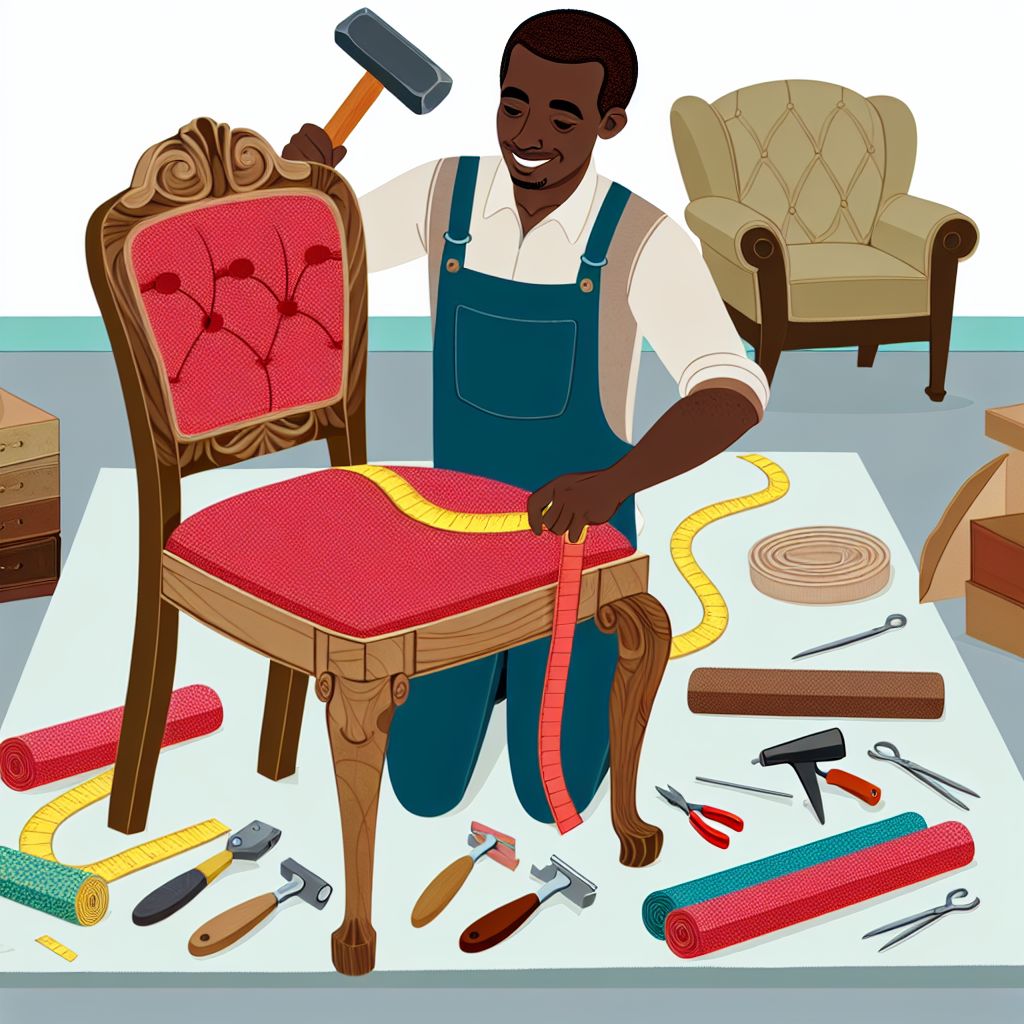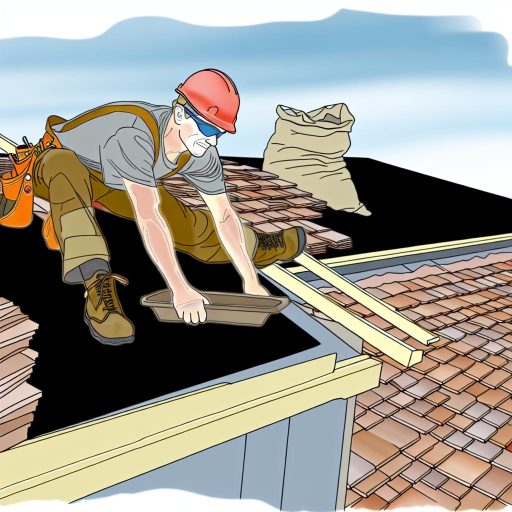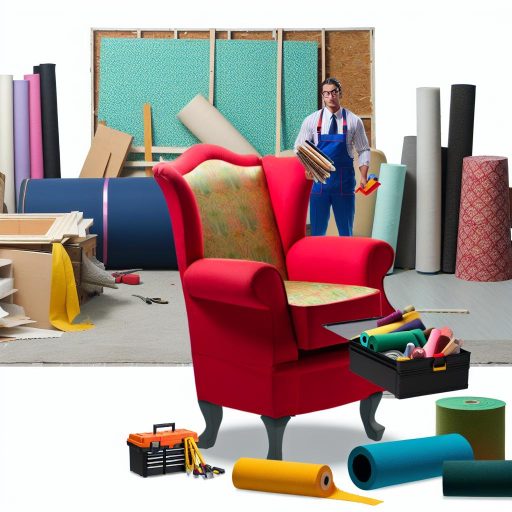Overview of the Role of an Upholsterer in the Furniture Industry
An upholsterer plays a vital role in the furniture industry.
They restore and refresh furniture pieces for both aesthetic and functional purposes.
Upholsterers work with various materials such as fabrics, leather, and padding.
Additionally, they utilize specialized tools and techniques to ensure quality craftsmanship.
Skills and Techniques
To excel, an upholsterer must have a keen eye for detail.
They should understand color matching, design principles, and fabric patterns.
Moreover, manual dexterity is essential for precise work on intricate designs.
Skills in sewing and pattern-making are also beneficial for upholstery tasks.
The Importance of Customization
Many customers seek personalized solutions for their furniture.
Upholsterers offer custom upholstery services tailored to client preferences.
This customization enhances the unique appeal of each piece.
As a result, they contribute significantly to the overall customer satisfaction.
Collaboration Within the Industry
Upholsterers often collaborate with designers and craftsmen.
This teamwork ensures that projects meet both aesthetic and functional requirements.
Moreover, they communicate with suppliers to source the best materials.
This collaboration ultimately benefits the quality of the final product.
Typical Work Environment
Tools of the Trade
An upholsterer uses a variety of specialized tools each day.
Essential tools include pneumatic staplers and sewing machines.
They also rely on precision tools like fabric scissors and seam rippers.
Measuring tapes and straight edges help ensure accurate cuts.
In addition, staple removers and glue guns prove handy for adjustments.
Materials Utilized
Upholsterers work with a range of materials daily.
They select high-quality fabrics based on client preferences.
Common materials include leather, cotton, and synthetic blends.
Foam and batting are crucial for providing comfort and support.
Unlock Your Career Potential
Visualize a clear path to success with our tailored Career Consulting service. Personalized insights in just 1-3 days.
Get StartedMoreover, they often use various types of wood for frames.
Workspace Setup
The typical workspace is organized for efficiency and safety.
Upholsterers maintain a clean area to prevent accidents.
Workbenches provide ample space for cutting and assembling items.
Shelves store tools and materials, keeping everything accessible.
Good lighting is essential for detailed work and inspections.
Morning Routine: Preparing for the Day and Reviewing Projects
Starting the Day Right
The sun rises early, and so do I.
I brew a strong cup of coffee to kickstart my morning.
As the aroma fills the kitchen, I take a moment to enjoy the stillness.
Reviewing My Schedule
I sit down at my workspace with my planner open.
I review the projects scheduled for the day.
Each project requires careful attention and planning.
Ensuring I have the necessary materials is essential.
Organizing Tools and Materials
I gather my tools, ensuring every piece is in its place.
This includes fabric, foam, and upholstery nails.
Each item plays a vital role in the day’s tasks.
I double-check my inventory for any missing supplies.
Preparing Mentally for the Tasks Ahead
The challenges of the day motivate me to focus.
I visualize each project and plan my approach.
Setting clear goals helps maintain my productivity.
Inspiration comes from previous projects I’ve enjoyed.
Connecting with Clients
I often take a moment to check emails and messages.
Staying connected with clients is crucial for successful outcomes.
Clear communication ensures everyone is on the same page.
I respond to inquiries and finalize schedules actively.
Embracing Creativity
As I prepare to start the projects, creativity flows.
Inspiration strikes from the fabrics and designs in front of me.
Each piece tells a story, and I am ready to shape it.
Starting Work
With everything in place, I step into my workshop.
The noise of the world fades, and focus takes over.
I begin the day’s first project with excitement and determination.
Gain More Insights: Steps to Becoming a Successful Ironworker in Canada
Morning Tasks: Measuring, Cutting, and Preparing Fabric
Starting the Day
A skilled upholsterer begins the day early to maximize productivity.
After arriving at the workshop, Alex takes a moment to review the day’s schedule.
This helps prioritize tasks and ensure everything runs smoothly.
Measuring for Precision
Accurate measurements are crucial in upholstery work.
Alex grabs a tape measure and prepares to measure the furniture.
Carefully, he measures each section, noting dimensions on a pad.
He occasionally double-checks to avoid any mistakes.
Cutting Fabric with Care
Once measurements are complete, Alex selects the right fabric.
He lays the fabric out on a large cutting table.
Using a sharp fabric cutter, he begins cutting the pieces.
Consistent cutting ensures a seamless fit during assembly.
Alex focuses, knowing that precision impacts the final look.
Preparing for Assembly
After cutting, Alex organizes the fabric pieces neatly.
He checks for any imperfections or flaws in the fabric.
If he finds anything, he addresses it before proceeding.
Finally, Alex sorts all materials needed for the project.
This includes padding, backing, and any decorative elements.
Collaboration and Communication
Throughout the morning, Alex communicates with his team.
He discusses any adjustments or design preferences with clients.
Effective communication ensures everyone is on the same page.
Discover More: Understanding the Art and Craft of Upholstery
Midday Tasks: Sewing and Assembling Upholstery Components
Sewing Upholstery Materials
At midday, the skilled upholsterer focuses on sewing various upholstery materials.
She carefully selects high-quality fabrics for each project.
Next, she ensures all fabric pieces fit together perfectly.
Using an industrial sewing machine, she stitches the components with precision.
She maintains a steady pace while paying attention to detail.
This step is crucial to achieving a polished final product.
Assembling Upholstery Components
After sewing, the upholsterer transitions to assembling the upholstery components.
She gathers the sewn pieces and prepares them for assembly.
Using specialized tools, she expertly aligns and secures each section.
She double-checks every joint to ensure stability and strength.
This phase often requires physical strength and dexterity.
A keen eye for design helps in aligning patterns seamlessly.
Quality Control
Once assembled, she conducts quality control checks on the items.
She inspects for any stitching errors or misalignments.
Her commitment to excellence shines through her meticulous review.
If she identifies issues, she swiftly makes necessary adjustments.
This dedication ensures customer satisfaction and builds a solid reputation.
Preparation for Final Touches
After ensuring quality, she prepares the upholstery for finishing touches.
This step includes adding padding or foam as needed.
She selects the best materials to enhance comfort and aesthetics.
Her choices reflect current trends and customer preferences.
Finally, the upholstery is ready for the finishing process.
Find Out More: Exploring the Artistry in Bricklaying Designs

Afternoon Activities: Client Consultations and Customizations
Client Consultations
In the afternoon, the busy schedule continues with client consultations.
This time allows for in-depth discussions about their needs.
Clients typically arrive with ideas and inspiration images.
First, I listen carefully to their vision for their furniture.
Next, I ask specific questions to guide the discussion.
Understanding their style helps shape the customization process.
I often take notes to capture critical details accurately.
After that, I show clients various fabric samples for selection.
This step is crucial as it directly affects the final look.
Customization Process
Once we finalize the fabric choice, the customization begins.
I explain the techniques I will use for their project.
Each piece of furniture requires a tailored approach.
Moreover, I outline the timeline for completion and delivery.
Clients appreciate knowing how long their project will take.
After our meeting, I start sketching ideas based on our discussion.
This stage allows me to visualize the transformations necessary.
Subsequently, I prepare a detailed plan that includes costs.
Clients receive a formal estimate to review at their convenience.
Once they approve, I schedule the work into my calendar.
Building Relationships
Establishing trust is vital in my client relationships.
I strive to create a welcoming atmosphere during consultations.
Personal connections enhance the overall experience for clients.
Therefore, I follow up with a thank-you message post-consultation.
This gesture reinforces my commitment to their project.
Additionally, many clients return for future projects.
An ongoing relationship leads to repeat business and referrals.
I take pride in seeing familiar faces come back.
Gain More Insights: Effective Communication Tips for Bricklayers
Quality Control in Upholstery
Importance of Quality Control
Quality control ensures every piece meets high standards.
It enhances customer satisfaction and brand reputation.
Moreover, it minimizes waste and reduces costs.
Inspecting Finished Pieces
The inspection process begins when a piece is completed.
Upholsterers examine every detail for quality assurance.
They look for defects in fabric and stitching first.
Additionally, they check the structural integrity of frames.
Each piece undergoes thorough scrutiny before leaving the workshop.
Common Adjustments Made
Adjustments are often necessary to meet quality standards.
These can include re-stitching loose seams or tightening frames.
Color matching is vital for fabric pieces as well.
Furthermore, upholstery may require padding adjustments for comfort.
Feedback and Continuous Improvement
Customer feedback plays a crucial role in quality control.
Upholsterers use this information to improve processes.
They hold regular team meetings to discuss quality issues.
Such collaboration supports a culture of continuous improvement.
Challenges Faced
Dealing with Difficult Materials
Upholsterers often encounter challenging materials in their work.
Some fabrics are tough to work with and require special tools.
For example, leather can be difficult to sew but yields beautiful results.
Additionally, some fabrics stretch or shift during the process.
These characteristics can complicate the upholstery work significantly.
Upholsterers must adjust their techniques based on the material.
Using the right tools is vital to handling challenging fabrics.
Some materials demand precision to avoid any noticeable flaws.
Ultimately, mastering these materials enhances an upholsterer’s skill set.
Handling Tight Deadlines
Many upholsterers face tight deadlines regularly.
Clients often expect quick turnarounds without sacrificing quality.
This pressure can create a stressful work environment.
To manage deadlines, efficient time management is essential.
Planning each step of the process helps streamline workflow.
Moreover, prioritizing tasks based on urgency can be beneficial.
Upholsterers often need to work overtime to meet client demands.
Effective communication with clients about timelines is critical.
Staying organized helps uphold quality despite time constraints.
Overall, meeting deadlines is a key aspect of a successful upholstery business.




